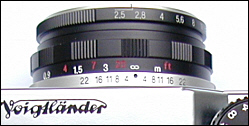| The Voigtländer Bessa-R | ||
|
The Camera Web Links |
||
|
Touch and Feel Part of the success of a camera is ease of use. If the camera is too clunky or its features too complicated, then it defeats the purpose of owning it.
I find the Bessa-R to be a very comfortable camera to hold and to use. It feels right when you hold it in your hands. The material that is used on the front and the back makes the camera easy to hold, although the camera back tends to accumulate nose prints and tiny scuff marks at an alarming rate. My only design quibble is the ergonomic bump on the camera back. The goal is to force you to place your thumb in the correct spot when winding the camera. But most people will hold the camera the correct way, and frankly where else would you put your thumb? I think it detracts from the very traditional look of the camera, even if it's functional. That said, I knew someone who advanced the film using an inverted index finger. I asked him what he was doing, and he said, "I'm winding the film. I always do it this way." So maybe the bump isn't a bad idea after all. The camera has a good feel. When using the camera, you'll be reminded that this type of camera was popular when the world wasn't in such a hurry. You'll need to spend time surveying your scene and subject, looking for the right angle and composing your shot. Shutter Noise The shutter isn't as quiet as you might expect or want. The camera isn't as loud as a traditional SLR, but I was surprised, because in theory it should be a much simpler and quieter mechanism because there is no need to flip a mirror with each exposure. The action of the shutter release is very smooth. And because the viewfinder never blacks out, it is very easy to follow your subject. I also think that it is easier to keep the camera steady when shooting with slower shutter speeds. Using the Camera If you haven't used a manual camera for a while, you'll have to get used to thinking again. Don't worry, that's a good thing. I would have preferred a match needle system with a real needle. I think the LED system is too broad. Maybe I'm a dinosaur on this, but I like seeing the sweep of a needle and knowing just how much over or under the exposure is. But I can understand why Cosina would choose LEDs: durability. LEDs don't fall out of alignment or get bent or stuck or gummed up with dried lubricant. All of the controls are just where you would expect. Your finger falls naturally on the shutter release. You don't have to hunt for it, and it doesn't compete with your attention with a myriad of buttons and switches. The shutter-speed dial — a bit too tightly sprung for me — is easy to find. But because you don't see the shutter or aperture settings in the viewfinder, you have to remember your starting point when making adjustments. You'll spend some time moving the camera down from your eye to see what shutter speed or aperture you had set until you get used to it. Like most rangefinder lenses, the aperture ring is near the front element, so you'll have to get accustomed to that. I found the focusing ring a bit small — not impossibly small ... just thinner than I expected.
Coming from an SLR background, it felt odd to be focusing with an all-metal ring. There is no rubber ribbing to help you grip the focusing ring. But that's how camera lenses were for decades. These days, it doesn't even enter my mind. Images snap into focus in the bright viewfinder. There has been talk of misalignment with the rangefinder, but I haven't seen that in my camera. You can focus using by either overlapping the images in the central rangefinder spot. Or you can align the two parts of a vertical section of your shot — such as the edge of a building or a light pole — to correctly focus. Whatever works. The image is very bright, and I had no problems focusing under most conditions — even a night scene, which traditionally has made many SLRs very difficult to use. Even worse at night are some of the autofocus cameras, which hopelessly zip to and fro, trying to find the focus point. Since buying the Bessa-R, I've bought and used many cameras. Many people compare the Bessa-R to the Leica. In my experience, the Leica is a refined camera that can't be equaled by the Bessa-R or most other cameras on the market. And that goes for the screw and bayonet Leicas. Still, I've been very impressed with the Bessa-R. I think most people will become comfortable with it in just a few minutes. As you might guess, I'm thrilled with this purchase. It was my first professional-level rangefinder — I owned a small Konica rangefinder in the late 1970s, but I don't remember what happened to it. I think I traded it for a Pink Floyd album ... no kiddng. It's a very pleasant experience. It will reinvigorate your interest in photography. |
||

